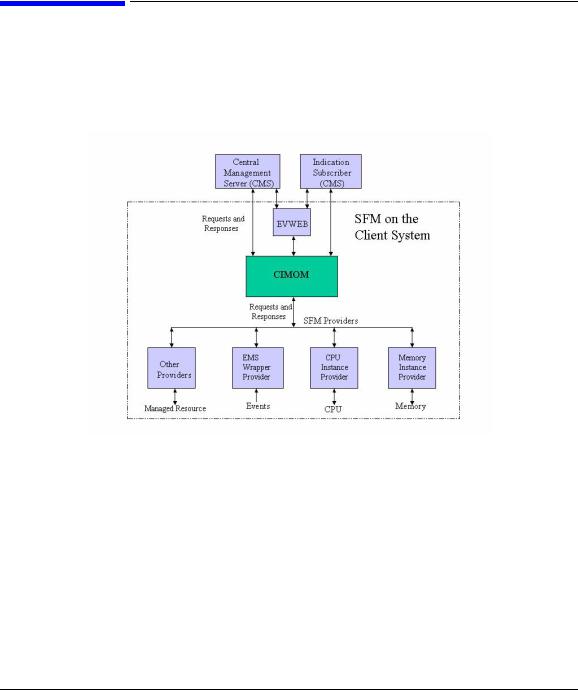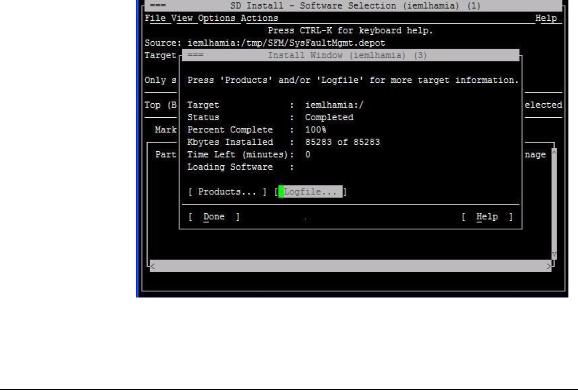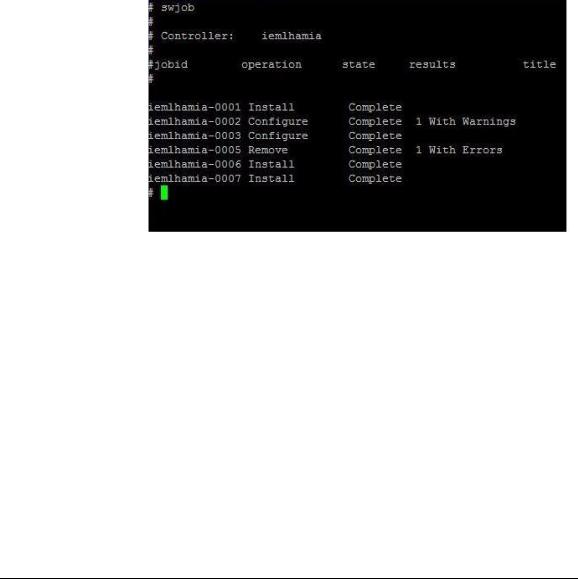HP HP-UX System Fault Management User Manual

System Fault Management Administrator’s
Guide
HP-UX 11i v1
Edition 1
Manufacturing Part Number: 5991-5475
E0604
© Copyright 2006 Hewlett-Packard Development Company, L.P.

Legal Notices
The information in this document is subject to change without notice.
Hewlett-Packard makes no warranty of any kind with regard to this manual, including, but not limited to, the implied warranties of merchantability and fitness for a particular purpose. Hewlett-Packard shall not be held liable for errors contained herein or direct, indirect, special, incidental or consequential damages in connection with the furnishing, performance, or use of this material.
Warranty
A copy of the specific warranty terms applicable to your Hewlett-Packard product and replacement parts can be obtained from your local Sales and Service Office.
U.S. Government License
Proprietary computer software. Valid license from HP required for possession, use or copying. Consistent with FAR 12.211 and 12.212, Commercial Computer Software, Computer Software Documentation, and Technical Data for Commercial Items are licensed to the U.S. Government under vendor's standard commercial license.
Trademark Notices
Linux is a U.S. registered trademark of Linus Trovalds. Windows is a U.S. registered trademark of Microsoft Corporation.
2

Contents
About This Document
1. Introduction
Overview. . . . . . . . . . . . . . . . . . . . . . . . . . . . . . . . . . . . . . . . . . . . . . . . . . . . . . . . . . . . . . 13
Features and Benefits . . . . . . . . . . . . . . . . . . . . . . . . . . . . . . . . . . . . . . . . . . . . . . . . . . . 14
Providers. . . . . . . . . . . . . . . . . . . . . . . . . . . . . . . . . . . . . . . . . . . . . . . . . . . . . . . . . . . . . . 15
Instance Providers . . . . . . . . . . . . . . . . . . . . . . . . . . . . . . . . . . . . . . . . . . . . . . . . . . . . 16
Indication Providers . . . . . . . . . . . . . . . . . . . . . . . . . . . . . . . . . . . . . . . . . . . . . . . . . . . 18
User Interfaces. . . . . . . . . . . . . . . . . . . . . . . . . . . . . . . . . . . . . . . . . . . . . . . . . . . . . . . . . 19
HP Systems Insight Manager . . . . . . . . . . . . . . . . . . . . . . . . . . . . . . . . . . . . . . . . . . . 19
HP System Management Homepage . . . . . . . . . . . . . . . . . . . . . . . . . . . . . . . . . . . . . . 19
Architecture . . . . . . . . . . . . . . . . . . . . . . . . . . . . . . . . . . . . . . . . . . . . . . . . . . . . . . . . . . . 20
2. Installing the SFM Software
Prerequisites . . . . . . . . . . . . . . . . . . . . . . . . . . . . . . . . . . . . . . . . . . . . . . . . . . . . . . . . . . 25 Installing the SFM Software from the Web . . . . . . . . . . . . . . . . . . . . . . . . . . . . . . . . . . 26 Verifying the Installation . . . . . . . . . . . . . . . . . . . . . . . . . . . . . . . . . . . . . . . . . . . . . . . . 27 Verifying the Installation Using the TUI . . . . . . . . . . . . . . . . . . . . . . . . . . . . . . . . . . 27 Verifying the Installation Using the CLI. . . . . . . . . . . . . . . . . . . . . . . . . . . . . . . . . . . 28 Removing the SFM Software. . . . . . . . . . . . . . . . . . . . . . . . . . . . . . . . . . . . . . . . . . . . . . 30 Removing the Software Using the TUI . . . . . . . . . . . . . . . . . . . . . . . . . . . . . . . . . . . . 30 Removing the Software Using the CLI . . . . . . . . . . . . . . . . . . . . . . . . . . . . . . . . . . . . 36 Verifying Removal of the SFM Software. . . . . . . . . . . . . . . . . . . . . . . . . . . . . . . . . . . . . 38 Verifying Removal Using the TUI . . . . . . . . . . . . . . . . . . . . . . . . . . . . . . . . . . . . . . . . 38 Verifying Removal Using the CLI . . . . . . . . . . . . . . . . . . . . . . . . . . . . . . . . . . . . . . . . 38 Configuring Indication Filters. . . . . . . . . . . . . . . . . . . . . . . . . . . . . . . . . . . . . . . . . . . . . 40 Configuring Error Logging in SFM. . . . . . . . . . . . . . . . . . . . . . . . . . . . . . . . . . . . . . . . . 41
3. Administering Indications and Instances Using HP SIM |
|
Creating Subscriptions and Viewing Indications Using HP SIM . . . . . . . . . . . . . . . . |
45 |
Creating Subscriptions . . . . . . . . . . . . . . . . . . . . . . . . . . . . . . . . . . . . . . . . . . . . . . . . . |
45 |
Viewing Indications . . . . . . . . . . . . . . . . . . . . . . . . . . . . . . . . . . . . . . . . . . . . . . . . . . . 56
Viewing Instances . . . . . . . . . . . . . . . . . . . . . . . . . . . . . . . . . . . . . . . . . . . . . . . . . . . . . . 62
Viewing Information About Processors . . . . . . . . . . . . . . . . . . . . . . . . . . . . . . . . . . . . 62
3

Contents
Viewing Information About Memory . . . . . . . . . . . . . . . . . . . . . . . . . . . . . . . . . . . . . . 64 Viewing Information About Cooling Devices and Power Supplies. . . . . . . . . . . . . . . 64 Viewing Information About Temperature and Voltage Status. . . . . . . . . . . . . . . . . . 67
4. Administering Indications and Instances Using HP SMH
Viewing Instances . . . . . . . . . . . . . . . . . . . . . . . . . . . . . . . . . . . . . . . . . . . . . . . . . . . . . . 71 Viewing Information About Processors . . . . . . . . . . . . . . . . . . . . . . . . . . . . . . . . . . . . 71 Viewing Information About Cooling Devices. . . . . . . . . . . . . . . . . . . . . . . . . . . . . . . . 72 Viewing Information About Physical Memory . . . . . . . . . . . . . . . . . . . . . . . . . . . . . . 72 Viewing Information About Power Supplies . . . . . . . . . . . . . . . . . . . . . . . . . . . . . . . . 72 Viewing Information About Temperature and Voltage. . . . . . . . . . . . . . . . . . . . . . . . 73
Administering Indications Using EVWEB . . . . . . . . . . . . . . . . . . . . . . . . . . . . . . . . . . . 74 Overview . . . . . . . . . . . . . . . . . . . . . . . . . . . . . . . . . . . . . . . . . . . . . . . . . . . . . . . . . . . . 74 Launching EVWEB for Administration. . . . . . . . . . . . . . . . . . . . . . . . . . . . . . . . . . . . 75 Configuring Email Consumer . . . . . . . . . . . . . . . . . . . . . . . . . . . . . . . . . . . . . . . . . . . 76 Creating EVWEB Event Subscriptions . . . . . . . . . . . . . . . . . . . . . . . . . . . . . . . . . . . . 77 Modifying EVWEB Event Subscriptions . . . . . . . . . . . . . . . . . . . . . . . . . . . . . . . . . . . 81 Deleting EVWEB Event Subscriptions . . . . . . . . . . . . . . . . . . . . . . . . . . . . . . . . . . . . 85
Viewing Event Subscriptions . . . . . . . . . . . . . . . . . . . . . . . . . . . . . . . . . . . . . . . . . . . . . 87 Overview . . . . . . . . . . . . . . . . . . . . . . . . . . . . . . . . . . . . . . . . . . . . . . . . . . . . . . . . . . . . 87 Viewing EVWEB Event Subscriptions . . . . . . . . . . . . . . . . . . . . . . . . . . . . . . . . . . . . 88 Viewing External Event Subscriptions . . . . . . . . . . . . . . . . . . . . . . . . . . . . . . . . . . . . 90 Viewing Indications . . . . . . . . . . . . . . . . . . . . . . . . . . . . . . . . . . . . . . . . . . . . . . . . . . . . . 92 Launching EVWEB for Viewing WBEM Indications . . . . . . . . . . . . . . . . . . . . . . . . . 92 Searching WBEM Events . . . . . . . . . . . . . . . . . . . . . . . . . . . . . . . . . . . . . . . . . . . . . . . 93 Viewing Summary Information About WBEM Events. . . . . . . . . . . . . . . . . . . . . . . . 95 Viewing Detailed Information About WBEM Events . . . . . . . . . . . . . . . . . . . . . . . . . 96 Deleting WBEM Events from the Event Archive . . . . . . . . . . . . . . . . . . . . . . . . . . . . 97 Tracing EVWEB. . . . . . . . . . . . . . . . . . . . . . . . . . . . . . . . . . . . . . . . . . . . . . . . . . . . . . . 100 Overview . . . . . . . . . . . . . . . . . . . . . . . . . . . . . . . . . . . . . . . . . . . . . . . . . . . . . . . . . . . 100 Enabling Tracing Using EVWEB GUI . . . . . . . . . . . . . . . . . . . . . . . . . . . . . . . . . . . 103 Enabling Tracing Using EVWEB CLI . . . . . . . . . . . . . . . . . . . . . . . . . . . . . . . . . . . . 104 Modifying Tracing Using EVWEB GUI. . . . . . . . . . . . . . . . . . . . . . . . . . . . . . . . . . . 104 Modifying Tracing Using EVWEB CLI . . . . . . . . . . . . . . . . . . . . . . . . . . . . . . . . . . . 105 Disabling Tracing Using EVWEB GUI . . . . . . . . . . . . . . . . . . . . . . . . . . . . . . . . . . . 105 Disabling Tracing Using EVWEB CLI . . . . . . . . . . . . . . . . . . . . . . . . . . . . . . . . . . . 106
4

Contents
5. Troubleshooting SFM
Troubleshooting Instance Providers . . . . . . . . . . . . . . . . . . . . . . . . . . . . . . . . . . . . . . . 109
Troubleshooting Indication Providers. . . . . . . . . . . . . . . . . . . . . . . . . . . . . . . . . . . . . . 113
Troubleshooting EVWEB. . . . . . . . . . . . . . . . . . . . . . . . . . . . . . . . . . . . . . . . . . . . . . . . 119
Glossary . . . . . . . . . . . . . . . . . . . . . . . . . . . . . . . . . . . . . . . . . . . . . . . . . . . . . . . 123
Index . . . . . . . . . . . . . . . . . . . . . . . . . . . . . . . . . . . . . . . . . . . . . . . . . . . . . . . . . . 127
5

Contents
6

About This Document
This document describes how to install, administer, and troubleshoot the System Fault Management (SFM) software and its components.
Document updates may be issued between editions to correct errors or to document product changes. To ensure that you receive the updated or new editions, subscribe to the appropriate product support service. Contact your local HP sales representative for more information.
This document can also be found online at:
http://docs.hp.com/en/diag
Intended Audience
This document is intended for system administrators responsible for installing, and managing remote systems using SFM. This document is also intended for users working on the client systems. Administrators and users are expected to have knowledge of operating system concepts, commands, and online diagnostics tools.
This document is not a tutorial.
Publishing History
Table 1 lists the publishing history for this document.
Table 1 |
Publishing History |
||
|
|
|
|
Document |
Operating |
Publication |
|
Manufacturing |
Systems |
||
Date |
|||
Part Number |
Supported |
||
|
|||
|
|
|
|
5991-5475 |
11i Version 1 |
April 2006 |
|
|
|
|
|
Document Organization
System Fault Management Administrator’s Guide is divided into several chapters. Each chapter contains information on installing and administering SFM.
Chapter 1 Introduction Introduces the SFM software, SFM features and benefits, SFM providers, user interfaces, EVWEB, and the architecture of SFM.
Chapter 2 Installing the SFM Software Instructs how to install, verify, and remove the SFM software.
Chapter 3 Administering Indications and Instances Using HP SIM Describes how to use the HP Systems Insight Manager (HP SIM) GUI to administer indications and view instances on remote systems.
Chapter 4 Administering Indications and Instances Using HP SMH Describes how to use the HP System Management Homepage (HP SMH) GUI to administer indications and view instances on the local system.
Chapter 5 Troubleshooting SFM Describes how to troubleshoot SFM providers and EVWEB.
7

Typographic Conventions
This document uses the following conventions:
audit (5) |
An HP-UX manpage. In this example, audit is the name and 5 is the section in the HP-UX |
|
Reference. On the Web and on the Instant Information CD, it may be a link to the manpage |
|
itself. From the HP-UX command line, you can enter “man audit” or “man 5 audit” to view |
|
the manpage. See man (1). |
Book Title |
The title of a book. On the Web and on the Instant Information CD, it may be a link to the |
|
book itself. |
KeyCap |
The name of a keyboard key. Note that Return and Enter both refer to the same key. |
Emphasis |
Text that is emphasized. |
Bold |
The defined use of an important word or phrase. |
ComputerOutput Text displayed or generated by the system.
UserInput |
Commands and other text that you type. |
Command |
A command name or qualified command phrase. |
Variable |
The name of a variable that you can replace in a command or function or information in a |
|
display that represents several possible values. |
[ ] |
The contents are optional in formats and command descriptions. If the contents are a list |
|
separated by |, you can choose one of the items. |
{ } |
The contents are required in formats and command descriptions. If the contents are a list |
|
separated by |, you must choose one of the items. |
... |
The preceding element can be repeated an arbitrary number of times. |
| |
Separates items in a list of choices. |
HP-UX Release Name and Release Identifier
Each HP-UX 11i release has an associated release name and release identifier. The uname (1) command with the -r option returns the release identifier. Table 2 shows the releases available for HP-UX 11i.
Table 2 |
HP-UX Releases |
||
|
|
|
|
Release |
Release Name |
Supported Processor |
|
Identifier |
Architecture |
||
|
|||
|
|
|
|
B.11.11 |
HP-UX 11i v1.0 |
PA-RISC |
|
|
|
|
|
Related Information
Additional information about SFM is available at:
http://docs.hp.com/en/diag
Following lists the other documents on SFM:
System Fault Management Release Notes
System Fault Management Frequently Asked Questions
System Fault Management Provider Data Sheets
8

HP Welcomes Your Comments
HP welcomes your comments concerning this document. We are truly committed to providing documentation that meets your needs.
Send your comments or suggestions to: diag_lp@presskit.rsn.hp.com
Include the document title, manufacturing part number, and any comment, error found, in this document. Also, please include what we did right, so we can incorporate it into other documents.
9

10

1 Introduction
This chapter introduces you to the System Fault Management (SFM) software and the tools that SFM includes.
The chapter discusses the following topics:
Chapter 1 |
11 |

Introduction
•“Overview” on page 13
•“Features and Benefits” on page 14
•“Providers” on page 15
•“User Interfaces” on page 19
•“Architecture” on page 20
12 |
Chapter 1 |

Introduction
Overview
Overview
The SFM software is a collection of tools used to monitor the health of HP servers running HP-UX. SFM retrieves information about a system’s hardware devices such as CPU, memory, power supply, and cooling devices. SFM operates within the Web-Based Enterprise Management (WBEM) environment.
WBEM is an industry-wide standards-based initiative to aid the management of large scale systems. WBEM has the following components:
•A WBEM infrastructure, such as HP WBEM services. SFM uses the Common Information Model Object Manager (CIMOM) WBEM service to route query requests and responses between WBEM providers and clients. Clients must be compliant with the Common Information Model (CIM) (2.7) schema of the Distributed Management Task Force (DMTF).
•A WBEM-based network management application, such as the HP Systems Insight Manager (HP SIM) and HP System Management Homepage (HP SMH), a user interface for controlling and monitoring resources within a large-scale system. SFM can use HP SIM to display query information for local and remote systems.
•WBEM providers that obtain information. SFM includes instance and indication providers, which are one set of WBEM providers among many. SFM providers query and provide system hardware property and event information.
Chapter 1 |
13 |

Introduction
Features and Benefits
Features and Benefits
SFM dynamically queries on request property information about a hardware device on a local or remote system. It offers the following features and benefits:
•Displays information on standards-compliant graphical and command-line system management applications, such as HP SIM and HP SMH.
•Operates within the WBEM environment.
•Supports the Central Management Server (CMS) running on HP-UX, Linux®, or Windows®.
•Enables you to view and administer WBEM indications.
•Provides the same features and benefits as those found in the EMS Hardware Monitors.
NOTE |
SFM is the future replacement of EMS Hardware Monitors. |
|
|
14 |
Chapter 1 |

Introduction
Providers
Providers
SFM providers can be classified as instance providers or as indication providers. This section describes these providers.
Chapter 1 |
15 |

Introduction
Providers
Instance Providers
On request, an SFM instance provider dynamically queries the local or remote system for the property information described in Table 1-1 and reports the information to the CIMOM.
Table 1-1 |
Instance Providers |
|
|
|
|
|
|
|
Instance Provider |
|
Description |
|
|
|
|
|
CPU |
The CPU Instance Provider gathers the |
|
|
|
following types of information: |
|
|
|
• Logical processor information, such as: |
|
|
|
— |
Current clock speed |
|
|
— |
Processor family |
|
|
— |
Processor status information, |
|
|
|
including configuration and |
|
|
|
deconfiguration, failure status, and |
|
|
|
active and inactive status |
|
|
— |
Load percentage |
|
|
• Physical processor chip information, |
|
|
|
such as chip revisions and architecture |
|
|
|
revisions |
|
|
|
• Location details, such as: |
|
|
|
— Location attributes such as cabinet |
|
|
|
|
number, cell number, slot number, |
|
|
|
and so on. Only information for |
|
|
|
filled slots is available. |
|
|
— |
Processor IDs |
|
|
The CPU Instance Provider depends on the |
|
|
|
EMS Wrapper Provider to update the |
|
|
|
processor inventory. |
|
|
|
|
|
16 |
Chapter 1 |

|
|
|
|
Introduction |
|
|
|
|
Providers |
Table 1-1 |
Instance Providers (Continued) |
|
||
|
|
|
|
|
|
Instance Provider |
|
|
Description |
|
|
|
||
|
Memory |
The Memory Instance Provider gathers the |
||
|
|
following types of information: |
||
|
|
• |
Memory slot information |
|
|
|
• Memory module information, such as: |
||
|
|
|
— |
Serial number |
|
|
|
— |
Part number |
|
|
|
— |
Memory capacity |
|
|
|
— |
Module form factor |
|
|
|
— Module status (for example, |
|
|
|
|
|
configuration status, failure status) |
|
|
The Memory Instance Provider depends on |
||
|
|
the EMS Wrapper Provider to update the |
||
|
|
memory inventory. |
||
|
|
|
||
|
Environmental |
The Environmental Instance Provider |
||
|
|
gathers information about the following |
||
|
|
hardware components: |
||
|
|
• |
Fans |
|
|
|
• |
Power supply |
|
|
|
• |
Bulk power supply |
|
|
|
• |
AC input lines |
|
|
|
|
||
|
Filter Metadata (FMD) |
The FMD Instance Provider does the |
||
|
|
following: |
||
|
|
• Provides the ability to predefine a filter |
||
|
|
|
in a repository |
|
|
|
• Ensures that chosen indications are |
||
|
|
|
logged to the Event Archive |
|
|
|
• Creates HP-advised subscriptions |
||
|
|
|
when SFM is installed |
|
|
|
|
|
|
Chapter 1 |
17 |

Introduction
Providers
Indication Providers
SFM includes one indication provider called the EMS Wrapper Provider. This provider converts hardware events received from EMS Hardware Monitors into WBEM indications. The EMS Hardware Monitors constantly monitor the system hardware resources for any unusual activity. When any unusual activity is detected on a monitored resource, the EMS monitor that is monitoring the resource generates an event that includes details of the problem and notify the EMS Wrapper Provider through the EMS framework. The EMS Wrapper Provider receives these events and converts them into WBEM indications.
The EMS Wrapper Provider then reports these indications to the CIMOM. Using a WBEM-based management application, such as HP SIM, you can subscribe to and receive Event Monitoring Service (EMS) events generated on a remote system. On the system on which SFM is installed, you can use an SFM tool called EVWEB to view and administer events through the HP SMH interface.
NOTE |
The terms events and indications are used interchangeably. |
|
|
18 |
Chapter 1 |

Introduction
User Interfaces
User Interfaces
You can use two types of interfaces to view SFM provider queries: HP SIM and HP SMH. This section describes these interfaces.
HP Systems Insight Manager
HP SIM is a WBEM-based user interface for controlling and monitoring resources within a large-scale system. You can use HP SIM to create subscriptions and to view indications and instances on a remote system. You must install HP SIM on the CMS. You can use HP SIM to launch HP SMH.
HP System Management Homepage
HP SMH is a secure, Web-based management application. You must install HP SMH on a local system to view hardware configuration, status data, performance metrics, system thresholds, and software version control information. You can also launch HP SMH from HP SIM remotely.
Chapter 1 |
19 |

Introduction
Architecture
|
Architecture |
|
Figure 1-1 illustrates the architecture of SFM installed on a |
|
PA-RISC-based client system. The client system is managed by the CMS. |
Figure 1-1 |
Block Diagram of SFM on PA-RISC-Systems |
The following list describes the sequence of events when a request is made for information:
1.The CIMOM receives requests from the CMS for device information.
2.The CIMOM converts the requests to a format that is deciphered by the SFM providers and directs the requests to the appropriate SFM provider, for example, the CPU Instance Provider.
3.The SFM provider queries the associated hardware device for property information.
4.The SFM provider returns the query information to the CIMOM.
5.The CIMOM conveys the responses from the provider to the CMS.
20 |
Chapter 1 |

Introduction
Architecture
Information can be viewed using HP SIM on the remote system and HP SMH on the local system.
The following list describes the sequence of events when an event is generated from an EMS monitor:
1.The EMS Wrapper Provider receives events generated by the EMS monitors through the EMS framework.
2.The provider converts these events into WBEM indications and reports these indications to the CIMOM.
3.The CIMOM directs these indications to EVWEB and to the CMS that has created subscriptions for indications. EVWEB then stores the indications either in the Event Archive or in your E-mail box, or both, depending on your configuration.
Indications can be viewed using HP SIM on the remote system and HP SMH on the local system.
Chapter 1 |
21 |

Introduction
Architecture
22 |
Chapter 1 |

2 |
Installing the SFM Software |
For HP-UX 11i v1, the System Fault Management (SFM) software is available only on the Software Depot. This chapter describes how to install the SFM software on the HP-UX 11i v1 operating system.
Chapter 2 |
23 |

Installing the SFM Software
This chapter discusses the following topics:
•“Prerequisites” on page 25
•“Installing the SFM Software from the Web” on page 26
•“Verifying the Installation” on page 27
•“Removing the SFM Software” on page 30
•“Verifying Removal of the SFM Software” on page 38
•“Configuring Indication Filters” on page 40
•“Configuring Error Logging in SFM” on page 41
24 |
Chapter 2 |

NOTE
Installing the SFM Software
Prerequisites
Prerequisites
Following are the prerequisites for installing the SFM software:
•HP-UX 11i v1 September 2005 Operating Environment Update Release (OEUR) or later
•OpenSSL Version A.00.09.07e.012 or later
•WBEM Services Version A.02.00.09 or later
•SysMgmtWeb Version A.2.2.2 (HP-UX Web-Based System Management User Interface)
•Online Diagnostics (OnlineDiag bundle B.11.11.16.xx)
Table 1-1 lists the versions of Online Diagnostics that support the SFM software. All later versions of Online Diagnostics will support the SFM software in the future.
Table 2-1 |
Online Diagnostics Versions |
|
|
|
|
|
EMS Version |
A.04.20 |
|
|
|
|
STM Version |
A.49.10 |
|
|
|
•PHSS_33033
•PHCO_31903
•PHCO_31923
All the prerequisites are available in the Software Depot. All the patches are available at:
http://itrc.hp.com
The PHCO_31903 patch depends on the PHCO_24402 patch.
HP recommends that you install HP Systems Insight Manager (HP SIM) version 5.0.01 to remotely administer indications and instances.
Chapter 2 |
25 |

Installing the SFM Software
Installing the SFM Software from the Web
|
|
Installing the SFM Software from the Web |
|
|
To install the SFM software from the Software Depot, complete the |
|
|
following steps: |
Step |
1. |
Go to HP Software Depot at: |
|
|
http://www.hp.com/go/softwaredepot |
Step |
2. |
Search for SysFaultMgmt. The Overview page is displayed. |
Step |
3. |
Go to the Installation page and review Prerequisites to ensure that your |
|
|
system meets the requirements. |
Step |
4. |
Select the Receive for Free >> option at the bottom right of the page. |
Step |
5. |
Select the appropriate release of the HP-UX operating system. |
Step |
6. |
Enter your registration information. Read and accept the terms and |
|
|
conditions. |
Step |
7. |
Click Next >> at the bottom right of the page. |
Step |
8. |
Click the appropriate link under Download Software to download the |
|
|
software. Save the software in a local directory on your system, for |
|
|
example, /tmp/SysFaultMgmt.depot. |
Step |
9. |
To install the product, login as superuser and enter the following |
|
|
command: |
|
|
# swinstall -s <full path of depot> SysFaultMgmt |
|
|
For example, |
# swinstall -s /tmp/SysFaultMgmt.depot SysFaultMgmt
Step 10. To verify whether the SFM software is installed properly, enter the following command at the HP-UX prompt:
# swlist | grep SysFaultMgmt
If the SFM software is installed properly, SysFaultMgmt and the version number appear in the output. If the SFM software is not installed properly, you must repeat the installation procedure. For more information, see “Verifying the Installation” on page 27.
26 |
Chapter 2 |

|
|
|
|
Installing the SFM Software |
|
|
|
|
Verifying the Installation |
|
|
|
|
|
|
|
|
|
Verifying the Installation |
|
|
|
|
This section describes how to verify the SFM software installation using |
|
|
|
|
the TUI and the CLI. |
|
|
|
|
|
NOTE |
|
|
|
The version numbers of the products shown in the figures may be |
|
|
|
|
different from the version you are installing. |
|
|
|
|
Verifying the Installation Using the TUI |
|
|
|
|
|
|
|
|
|
To verify the SFM software installation, complete the following steps: |
Step |
1. |
|
Log in to the system as a superuser. |
|
Step |
2. |
|
Click Logfile in the Install window, as shown in the following figure: |
|
Chapter 2 |
27 |

Installing the SFM Software
Verifying the Installation
The Logfile, which includes details about the installation, is displayed. If there are no errors in the Logfile, the SFM software is installed properly. If the SFM software is not installed properly, you must repeat the installation procedure.
Step 3. For information about errors related to installation, enter the following command at the HP-UX prompt:
# swjob -a log <jobid> @ <system name>:/
The jobid is available in the Logfile, as underlined in the Logfile window, in the following figure:
For example, enter the following command at the HP-UX prompt:
# swjob -a log iemlhamia-0013 @ iemlhamia.india.hp.com:/
Verifying the Installation Using the CLI
To verify your installation using the CLI, complete the following steps:
Step 1. Log in to the system as a superuser.
28 |
Chapter 2 |

Installing the SFM Software
Verifying the Installation
Step 2. Enter the following command at the HP-UX prompt:
# swjob
If the output contains no errors, the SFM software is installed properly. Otherwise, you must install the SFM software again.
A sample output is shown in the following figure:
Step 3. For information about installation-related errors, enter the following command at the HP-UX prompt:
# swjob -a log <jobid> @ <system name>:/
Chapter 2 |
29 |

Installing the SFM Software
Removing the SFM Software
CAUTION
Removing the SFM Software
This section describes how to remove of the SFM software using the TUI and the CLI.
Removing the SFM software makes your system vulnerable to failure. Also, all the software products that depend on the SFM software may not work properly.
NOTE |
The version numbers of the products shown in the figures may be |
|
different from the version you are installing. |
|
|
Removing the Software Using the TUI
To remove the SFM software from your system, complete the following steps:
Step 1. Log in to the system as a superuser.
Step 2. Enter the following command at the HP-UX prompt:
# swremove
30 |
Chapter 2 |
